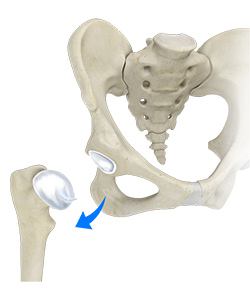Surgical Dislocation

Surgical hip dislocation is a procedure in which the hip is dislocated to allow better access and visualization of the articulating surfaces of the joint. While arthroscopy, a minimally invasive procedure associated with faster healing, is used most commonly to treat hip impingement, more complex forms of impingement are sometimes better treated with surgical hip dislocation.
Diagnosis
Conditions more commonly treated by surgical dislocation include the residuals of pediatric hip diseases including Legg-Calve-Perthes disease (a loss of blood flow to the femoral head during childhood) and slipped capital femoral epiphysis (a fracture through the growth plate of the hip in the teenage years).
Surgical Procedure
Surgical hip dislocation is performed under general combined with spinal anesthesia. Your surgeon makes an incision along the side of your hip. The upper part (greater trochanter) of your thigh bone (femur) is cut to allow access to the joint without incising much muscle tissue. Arteries and nerves are carefully protected. The bones are then disjointed and the articular surfaces treated. The surgical dislocation approach allows the surgeon to treat shape abnormalities and cartilage and labral injuries in the hip joint. After re-articulating the bones, the cut part of the femur is replaced and fixed with screws. Commonly, another cut in the femur (a femoral osteotomy) or lengthening of the femoral neck is performed at the same time to address associated deformity of the femur. The incision is then closed and covered with a gauze dressing. The entire procedure takes about 2-3 hours. Ice is applied to control pain and swelling for which your doctor also prescribes medication. You are placed on crutches for about 6 weeks.
Post-Operative Care
Patients are admitted to the hospital for one or two days to make sure their pain is controlled, and they can get around safely. You are placed on crutches for about 6 weeks while the bones and soft tissues are healing. X-rays are obtained at 2 and 6 weeks after surgery to make sure that the bones are healing normally. After six weeks patients are normally progressed to start physical therapy and a full recovery takes about 6 months
Risk and Complications
Surgical hip dislocation carries a risk of damage to the blood supply of the head of the femur. Other risks may include blood loss, non-healing of cuts made in the bone (osteotomies) formation of bone in the soft tissues (also known as heterotopic ossification), infection and nerve damage, which may occur with any surgery.
